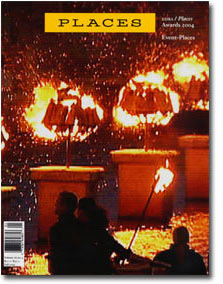Berkeleyan
The changing nature of Places
CED journal stays true to its mission while expanding its reach
![]()
| 09 February 2005
 Places attempts to bridge the worlds of research and design. |
Over the past two decades, Lyndon’s focus, and that of the journal Places, have remained constant. Since its debut in 1983 the journal’s editors have taken a cross-disciplinary approach, drawing from architecture, city planning, landscape architecture, and related fields simultaneously, rather than focusing on one or another area exclusively.
Hence, Places’ fall 2004 issue looks at the dehumanizing effect of cookie-cutter public housing structures, offers a meditation on the design of modern transit stations, and examines “event-places” where social gatherings are very much linked to their physical location, such as the Mummers Parade in Philadelphia or the Smithsonian Folklife Festival in Washington, D.C. Also included are the seventh annual Environmental Design Research Association/Places Awards, an annual feature in the three-times-a-year publication. The narratives and jury commentary that accompany the place, design, and research awardees are thoughtful, scholarly, and surprisingly light on technical terminology that readers outside the ivory tower might find offputting.
That’s no accident, says managing editor David Moffat. The editors observe a “no-jargon” rule in their pages in hope of expanding Places’ readership and building a bridge between university researchers and what Moffat calls “a more educated general populace that can appreciate serious discussion of these issues.”
Deans on the board … copy to follow
Since the journal’s founding, says Lyndon, the editors, realizing they were “crossing boundaries” with their interdisciplinary approach, wanted “to not talk only to the professional decision-makers but to address the stewards of the environment as well.”
The College of Environmental Design had existed for 20 years already, “but to some extent ‘environmental design’ was still a controversial term.” Places, he says became a way of bringing people together across professional and institutional boundaries to explore new formulations of design purpose and process.
Confronting uncertainty on several fronts during its early years — the death of one founding editor, the resignation of another, funding woes, and the like — Places seems to have stabilized with its incorporation into the Design History Foundation, a nonprofit organization established by former publisher Jim Fulton. A consortium of partners comprised of MIT, the University of Miami, the Georgia Institute of Technology, Pratt Institute, and the University of Michigan contributes to Places’ publishing costs.
“Places has gone through different cycles,” says David Moffat, managing editor for the past two years. “We’re definitely entering into a new cycle now where we have new people involved, expanded goals, and a new structure for the journal.”
The journal’s editorial advisory board — most of which is made up of deans of their respective architecture schools — meets twice a year to choose themes for forthcoming issues and encourage their own faculties and students to submit articles. “It’s very stimulating and exciting,” says Lyndon. “We’re getting material we would never have gotten before.”
Occasionally, board members take on guest-editor duties. Ellen Dunham Jones, director of the architecture program at Georgia Tech, helmed an upcoming issue on “retrofitting suburbia,” bringing in many contacts and editorial referees.
From the start, says Lyndon, he and founding editor William Porter held “an absolute position that Places is not a house journal for a single university.” However, the publication does draw from a strong network of Berkeley contributors. Those include Allan Jacobs, professor emeritus in the Department of City and Regional Planning and a former city of San Francisco planning director; Peter Bosselman, chair of landscape architecture and adviser for the urban design program; Marcia McNally, an associate adjunct professor in landscape architecture and environmental planning; Renee Chow, an associate professor of architecture; Mark Anderson, assistant professor in architecture; and Harrison Fraker, dean of the College of Environmental Design.
“The members of our editorial group all come from different backgrounds,” says managing editor Moffat, “but they can all communicate in and through the journal. In that sense, you might think of Places as a meeting room for people with common ideas.”
The spring 2005 issue of Places will be published in late April. Single copies of the journal are available through CED’s Center of Environmental Design Research in 390 Wurster Hall. For subscription information, visit www.places-journal.org.

